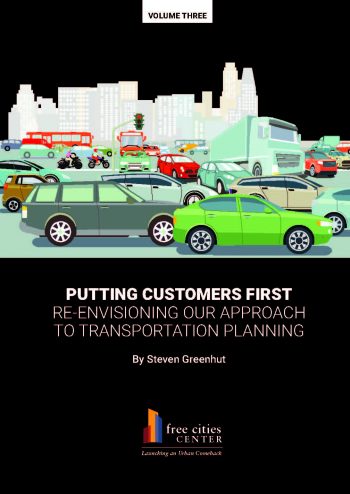State Planners Focus Too Much on Social Engineering Rather Than Transportation Engineering
Focus Should Be Easing Gridlock, Not Prodding People Out of Cars
State and local transportation officials are planning transportation projects around social engineering, rather than building transportation systems that meet customers where they are and where they want to go, concludes a new book released today by the Free Cities Center at the nonpartisan, free-market think tank, the Pacific Research Institute.
Download a copy of “Putting Customers First” at www.pacificresearch.org/freecities
“Public transit ridership is falling in California and across the country—not just because of the COVID-19 pandemic, but because many transit systems are not appealing to ride,” said Steven Greenhut, the author of “Putting Customers First” and the director of PRI’s Free Cities Center. “Our new book explores market-based reforms to make transit more hospitable to customers and prioritize new freeway and road construction, without hectoring drivers to get out of our cars.”
Greenhut writes that It’s true, as critics say, that freeways have often been built over the years in ways that bisected functioning neighborhoods. But the answer, he argues, isn’t to stop building freeways as the state has done in recent years. Rather, additional highway capacity should be built in the right places where they’re necessary.
State lawmakers passed Senate Bill 1 in 2017 to increase transportation funding by $52 billion. Voters who upheld the law at the ballot box, Greenhut notes, were told that these dollars would be used for critical projects to reduce traffic gridlock. But a lot of that money went for social engineering, rather than transportation engineering.
Cities such as Sacramento, for example, used the money to impose “road diets,” whereby money that was supposed to be used to increase road capacity was actually used to reduce road capacity. The city has reduced the number of lanes for automobile traffic on busy streets like J Street in Downtown Sacramento and replacing them with new bike lanes. These policies, Greenhut argues, increase congestion and make Californians increasingly cynical about how our money is spent.
The money that is spent in California is not well spent. He cites the Reason Foundation’s latest report on state highway building, which found that California spends nearly three times per mile more than Texas ($205,924 v. $75,153) on building roads and freeways.
“One of the things that California’s transportation planners fail to do is put customers first. Instead of trying to change our behavior, California’s transportation planners need to build the roads, freeways, bridges and streets that meet us where we are, rather than spending so much time trying to convince us to abandon our cars and take transit,” said Greenhut.
PRI’s Free Cities Center cultivates innovative ideas to improve urban life based around freedom and property rights – not government. It regularly releases incisive reporting and analysis on crime, housing, education, homelessness, and social mobility. Follow PRI on Facebook, Twitter, and LinkedIn.


